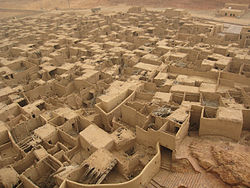Al-`Ula
| Al-ʿUla | |
|---|---|

Al-`Ula old town
|
|
| Coordinates: 26°37′N 37°55′E / 26.617°N 37.917°ECoordinates: 26°37′N 37°55′E / 26.617°N 37.917°E | |
| Country |
|
| Region | Al Madinah |
Al-ʿUla (also Al Ola, Arabic العلا al-ʿulā; Also Dedan), is a city some 110 km southwest of Tayma (380 km north of Medina) in north-western Saudi Arabia. Al-Ula was historically located on the Incense route.
It was the capital of the ancient Lihyanites (Dedanites). It is well known for archaeological remnants, some over 2000 years old.
The older history of the oasis has been divided into several phases. The Dedanite kingdom spans to the seventh and sixth century BC. Dedan is mentioned in the "Harran Inscriptions". In these it is told how Nabonidus the king of Babylonia made a military campaign to northern Arabia in 552 BC or somewhat later, conquering Tayma, Dedan and Yathrib, the old Medina. It is thought that around the turn to the fifth century BC the kingdom became hereditary.
The next four hundred years, until around 100 BC, were the time of the Kingdom of Lihyan. The Nabataeans were the lords of the region at least until 106 AD when the Romans conquered their capital Petra. The Nabataeans made Hegra, the modern Mada'in Saleh, their second capital. The power center of the region thus shifted to Hegra some 22 km to the north of Al-`Ula.
Muhammad passed through Al-`Ula in 630 on his campaign to Tabuk. Al-Mabiyat some 20 km away near Mughaira became the next commercial center of the region. It thrived from around 650 until it declined at some time before 1230.
In the 13th century the old city of Al-`Ula was built and many stones of the old Dedanite and Lihyanite ruins were reused. Al-`Ula now became the major settlement of the region again until modern times. A railway station was built for the Hejaz railway in 1901-08. The railway line was built through the western part of Al-Khuraiba some twelve kilometers to the north of the old medieval town which is believed to be the site of the old Dedanite and Lihyanite town. In the 20th century the new town center was established beside the old town and eventually the people left the old buildings. The last family is said to have left in 1983, while the last service in the old mosque was held in 1985. Both the ruins of the medieval town and the site of the Liyhanite settlement now lay within the limits of the modern town.
...
Wikipedia

